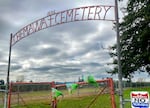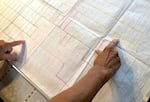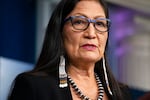Leaders at the federal agency responsible for creating and operating hundreds of boarding schools for Native American children over the last two centuries have issued a damning report of that system.

The Chemawa Cemetery, shown here in this March 22, 2022 photo, is one of many cemeteries and burial grounds where countless Native American children were laid to rest after dying at federal boarding schools, often hundreds or thousands of miles from home. Up until a federal report released Wednesday, the U.S. government had never comprehensively documented the many cemeteries and burial grounds.
Rob Manning / OPB
The “Federal Indian Boarding School Initiative Investigative Report” released by the U.S. Department of Interior Wednesday, documents the breadth and intent of the schools and makes clear they were part of a coordinated strategy aimed at subjugating Indigenous people by forcibly assimilating their children. The report roots the racist policies against Native Americans to the views of founding fathers George Washington and Thomas Jefferson and documents generations of intergenerational trauma – leading up to the psychological pain experienced by Indigenous people today.
And for the first time, the federal government has made an official count of those schools, and an initial list of burial grounds for children who died at them.
The report traces the traumatic Indian boarding school era back to 1801, though its longest-running schools opened decades later, including a school in Forest Grove, Oregon.
Throughout, the report’s authors connect the boarding schools to broader efforts to defeat Native people. The report’s first page discusses the surrender of the Apache to the U.S government in 1886, noting how the military responded: by imprisoning tribal leaders in Florida, and sending Apache children to Pennsylvania.
“Under U.S. military control, surviving Apache children were forcibly removed from their families and shipped by train to the Carlisle Indian Industrial School in Pennsylvania,” the report recounts.

Eleven Spokane children were photographed in Portland in July 1881 on their way from what is now eastern Washington to the Forest Grove Indian Training School. Historians believe Martha Lot, the daughter of Chief Lot, is the tallest girl in the back row. She died in Forest Grove and is believed to be buried in an unmarked grave in the city cemetery.
Courtesy of Pacific University
Until today the U.S. government has not possessed an official count of the boarding schools it ran for more than a century and a half; the schools that were created as a way to assimilate Native American children, eradicate Indigenous cultures, and forcibly repossess tribal lands.
In the view of the person who ordered the report, Interior Secretary Deb Haaland, the investigation is aimed at examining the past to improve the present-day lives of Native people.
“The consequences of federal Indian boarding school policies — including the intergenerational trauma caused by the family separation and cultural eradication inflicted upon generations of children as young as 4 years old — are heartbreaking and undeniable,” said Haaland, the first Indigenous person to run the Interior Department.
Hundreds of schools, and graves
The report finds there were 408 schools — a number identical to what was compiled in publications by Denise Lajimodiere, a researcher, tribal member of the Turtle Mountain Ojibwe and co-founder of the National Native American Boarding School Healing Coalition. The coalition collaborated on the federal initiative.
The report says some of the schools operated at multiple sites, so the total number of federal Indian boarding school locations is 431. Those numbers don’t include orphanages, day schools or other institutions holding Native American children; those numbered more than 1,000, according to federal officials.

Longtime volunteer historian at Chemawa Indian School, SuAnn Reddick, points out burial sites on a grid, which maps out what's known about unmarked graves at the Chemawa cemetery, in this July 2021 file photo.
Rob Manning / OPB
Before the report, the U.S. government had also never comprehensively documented the many cemeteries and burial grounds where countless Native American children were laid to rest after dying at federal boarding schools, often hundreds or thousands of miles from home.
According to the report, at least 53 of the boarding schools operated by the federal government between 1819 and 1969 had burial grounds.
Only 33 of those known sites have “marked” burial sites.
The U.S. Department of Interior reports that “more site discoveries and data [are] expected as we continue our research.”
In addition to the numerical conclusions, the Interior Department’s investigation also confirmed connections between the federal effort to send Native American children to boarding schools and broader strategic goals of the U.S. government dating back to the turn of the 19th century. The report notes that Thomas Jefferson espoused an assimilationist approach toward Native Americans “to separate Indian Tribes from their territories.”
The report quotes from a confidential message Jefferson sent to Congress backing federal policies, “to encourage [Native Americans] to abandon hunting, to apply to the raising stock, to agriculture, and domestic manufacture, and thereby prove to themselves that less land and labor will maintain them in this better than in their former mode of living.”
The report goes on to note that boarding school administrators would give Native children English names, prevent children from speaking tribal languages and cut their hair.
Investigators found that treatment at the schools was often poor, with corporal punishment and isolation used regularly. School programs were often focused on manual labor, leading to “graduates with employment options often irrelevant to the industrial U.S. economy, further disrupting Tribal economies.”
One tactic the report notes, citing a 1969 congressional committee publication titled “Indian Education: A National Tragedy — A National Challenge,” involved Chemawa Indian School in Salem and an effort to move children far from home to disrupt family and community connections.
“Navajo children were sent as far away as the Chemawa Boarding School [sic] in Oregon, and in turn displaced hundreds of Indian students from the Northwest who were rerouted to boarding schools in Oklahoma,” that 1969 report said, continuing “hundreds of Alaskan native children without schools [were sent] to the Chemawa School in Oregon and the overflow to boarding schools in Oklahoma. [In 1968], more than 400 Alaskan natives were sent to the Chilocco Boarding School in Oklahoma.”
According to a database published last year by researchers SuAnn Reddick and Eva Guggemos, many of the children who attended Chemawa, and died there, were Alaskan Natives. The Interior Department was tasked with compiling similar information on students who died at the schools, but officials said they were unable to do that, due to financial and logistical constraints. However, the detail of what information is ultimately released may be limited, as the report indicates, “the Department will protect sensitive information obtained from the investigation including, but not limited to, identities of Federal Indian boarding school attendees, including names and Tribal identities.”
A massive effort with more work coming
The investigation was initially launched last June, but an examination of schools run over the course of a century, all over the country, means a massive effort. The report’s authors note that their initial queries led archivists to identify nearly 40,000 boxes of potentially responsive records, much of it at the American Indian Records Repository in Lenexa, Kansas, located up to 90 feet underground.
As the report itself indicates, the investigation is far from complete, with whole categories of federal records still needing examination.
Assistant Secretary for Indian Affairs Bryan Newland supervised the report and noted that it should mark a change in direction in federal policy toward Native Americans.
“This report presents the opportunity for us to reorient federal policies to support the revitalization of Tribal languages and cultural practices to counteract nearly two centuries of federal policies aimed at their destruction,” Newland said in a release.
Haaland is already starting on that work in an upcoming tour she’s calling “The Road to Healing.”

In this April 23, 2021 photo, Interior Secretary Deb Haaland speaks during a news briefing at the White House in Washington. Secretary Haaland vowed on her first day on the job to ensure Native American tribes have opportunities to speak with her and the agencies she oversees. Native American and Alaska Native groups are seeing change under Haaland but some remain frustrated with the pace of action. (AP Photo/Evan Vucci, File)
Evan Vucci / AP
In a statement accompanying the release of the report, Interior Department officials said the tour is meant to, “allow American Indian, Alaska Native, and Native Hawaiian survivors of the federal Indian boarding school system the opportunity to share their stories, help connect communities with trauma-informed support, and facilitate collection of a permanent oral history.”
Haaland added that her agency is working with President Biden through the White House Council on Native American Affairs on an effort to preserve Tribal languages, invest in survivor-focused services, and honor obligations to Indigenous communities.
